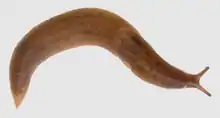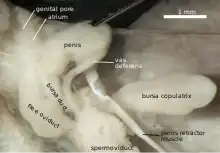Ambigolimax parvipenis
Ambigolimax parvipenis is a species of air-breathing land slug, a terrestrial pulmonate gastropod mollusc in the Limacidae.
| Ambigolimax parvipenis | |
|---|---|
 | |
| Scientific classification | |
| Domain: | Eukaryota |
| Kingdom: | Animalia |
| Phylum: | Mollusca |
| Class: | Gastropoda |
| Subclass: | Heterobranchia |
| Order: | Stylommatophora |
| Superfamily: | Limacoidea |
| Family: | Limacidae |
| Genus: | Ambigolimax |
| Species: | A. parvipenis |
| Binomial name | |
| Ambigolimax parvipenis Hutchinson, Reise & Schlitt, 2022[1] | |
| Synonyms | |
| |
Taxonomy
Ambigolimax parvipenis was first clearly characterised in 2014, based on specimens from the British Isles.[2][3] This work showed it to be distinct from the externally similar Ambigolimax valentianus on the basis both of genital anatomy and of the genetic sequences in the barcoding COI mitochondrial gene. The species later named Ambigolimax parvipenis was at that time referred to as Ambigolimax nyctelius (Bourguignat, 1861) because of some similarity in genital anatomy with a slug species from the Royal Botanic Garden Edinburgh that had been named Limax nyctelius or Lehmannia nyctelia[4] (since[1] renamed Ambigolimax waterstoni). These two slug species both lack a penial appendage but differ considerably in the length of the penis. In 2022[1] it was shown that they are indeed different species, that they had both been confused with an Eastern European species (Lehmannia carpatica), and furthermore that the slug originally named Limax nyctelius was yet another species.
Accordingly it was necessary to coin the new name Ambigolimax parvipenis.[5] The etymology of the name is the genitive of "parvus penis", the Latin for "small penis". The type locality is Almondbury churchyard, West Yorkshire, England.[1]
Occurrence and distribution
The native distribution is unknown. The species was recorded at several sites in Cornwall and Devon (SW England) in 1999–2000, but a 1987 record from Suffolk might also be this species. Since then it has spread widely in Britain and Ireland and by the end of 2021 was reported from 25 vice-counties in Britain and 3 in Ireland. It is known also from France, Hungary, Greece, and Spain, including the Canary Islands and Chafarinas Islands.[1][6] It is widespread in California[7] (earliest record = 2005), with one record from Arizona.[1]
The species is typically found in gardens and similar disturbed habitats.[3]
Historical (pre-2022) records of Limax nyctelius, Lehmannia nyctelia or Ambigolimax nyctelius from South Africa, Australia, New Zealand, Edinburgh and Elba are now known to be of A. waterstoni, and those from the Carpathian Mountains south to Bulgaria are of Lehmannia carpatica.[1]
Description

Adult slugs are up to 80 mm long when crawling but often mature at a much smaller size.[3] Like other limacids, they are slim with a pointed tail, and the pneumostome lies in the posterior half of the mantle. The mucus is transparent and colourless. The background colour is yellowish-grey to various shades of brown, with the flanks paler and the sole pale cream. Usually there are at least traces of a pair of dark lines running either side of the midline of the back, and another pair of dark lines on either side of the mantle. Often there are additional such longitudinal lines and spotting. None of these external characters reliably distinguish the species from Ambigolimax valentianus (which often co-occurs with A. parvipenis) or other species of Ambigolimax.[1][3][7]
The penis is distinctive by its small size (roughly half the length of the bursa copulatrix and duct) and lack of a penial appendage (although vestigial knobs are occasionally present). However, the penial appendage of A. valentianus may sometimes be inverted inside the penis, so slitting open the penis is necessary to confirm its absence.[1][3]
References
- Hutchinson, John M.C.; Reise, Heike; Schlitt, Bettina (30 June 2022). "Will the real Limax nyctelius please step forward: Lehmannia, Ambigolimax, or Malacolimax? No, Letourneuxia!". Archiv für Molluskenkunde. 151 (1): 19–41. doi:10.1127/arch.moll/151/019-041. S2CID 250188836.
- Rowson, Ben; Anderson, Roy; Turner, James A.; Symondson, William O.C. (16 April 2014). "The slugs of Britain and Ireland: undetected and undescribed species increase a well-studied, economically important fauna by more than 20%". PLOS ONE. 9 (4): e91907. Bibcode:2014PLoSO...991907R. doi:10.1371/journal.pone.0091907. PMC 3989179. PMID 24740519.
- Rowson, B.; Turner, J.; Anderson, R.; Symondson, B. (2014). Slugs of Britain & Ireland: identification, understanding and control (First ed.). Telford: Field Studies Council. ISBN 978-1908819130.
- Quick, H.E. (1949). Synopses of the British fauna. No. 8. Slugs (Mollusca) (Testacellidae, Arionidae, Limacidae). London: Linnean Society.
- "Ambigolimax parvipenis Hutchinson, Reise & Schlitt, 2022". Molluscabase. Retrieved 13 July 2022.
- Turóci, Á.; Hutchinson, J.M.C.; Schlitt, B.; Reise, H.; Rapala, M.; Páll-Gergely, B. (2023). "Five new introduced terrestrial slugs in Hungary". BioInvasions Records. 12 (3): 711-729. doi:10.3391/bir.2023.12.3.08. S2CID 261543248.
- Vendetti, Jann E.; Burnett, Emily; Carlton, Lidia; Curran, Anne T.; Lee, Cedric; Matsumoto, Ron; Mc Donnell, Rory; Reich, Inga; Willadsen, Ole (11 July 2019). "The introduced terrestrial slugs Ambigolimax nyctelius (Bourguignat, 1861) and Ambigolimax valentianus (Férussac, 1821) (Gastropoda: Limacidae) in California, with a discussion of taxonomy, systematics, and discovery by citizen science". Journal of Natural History. 53 (25–26): 1607–1632. doi:10.1080/00222933.2018.1536230. S2CID 92483299.